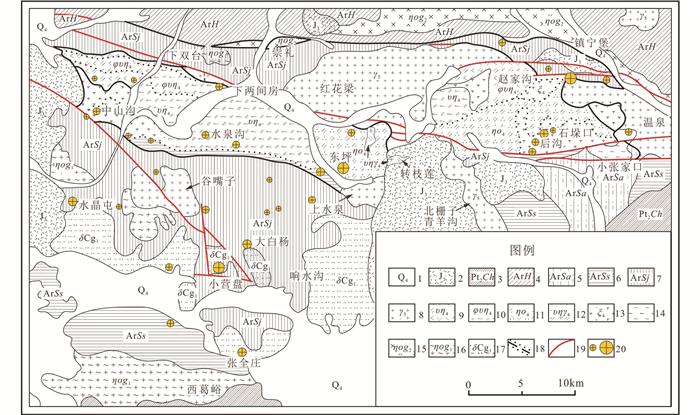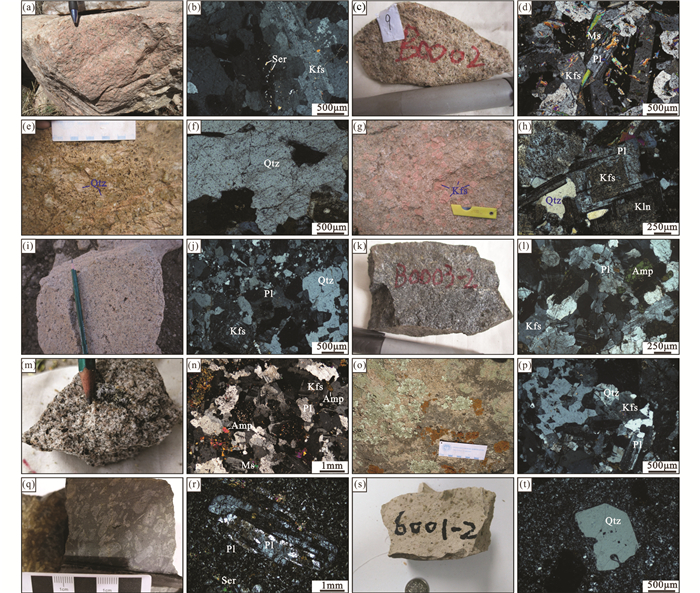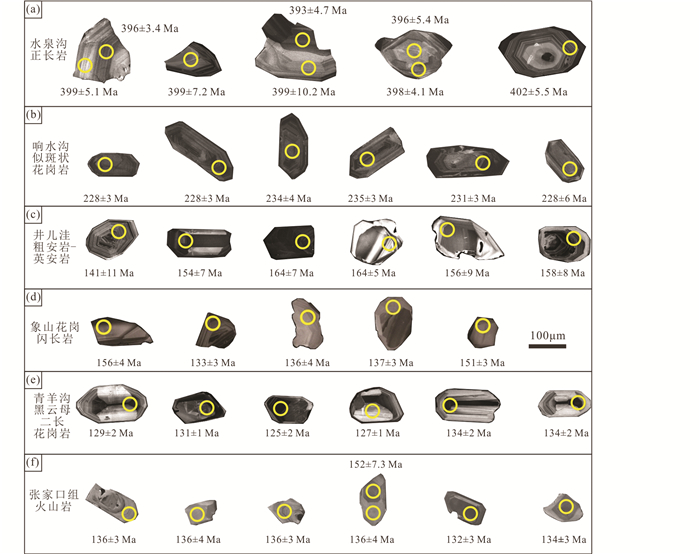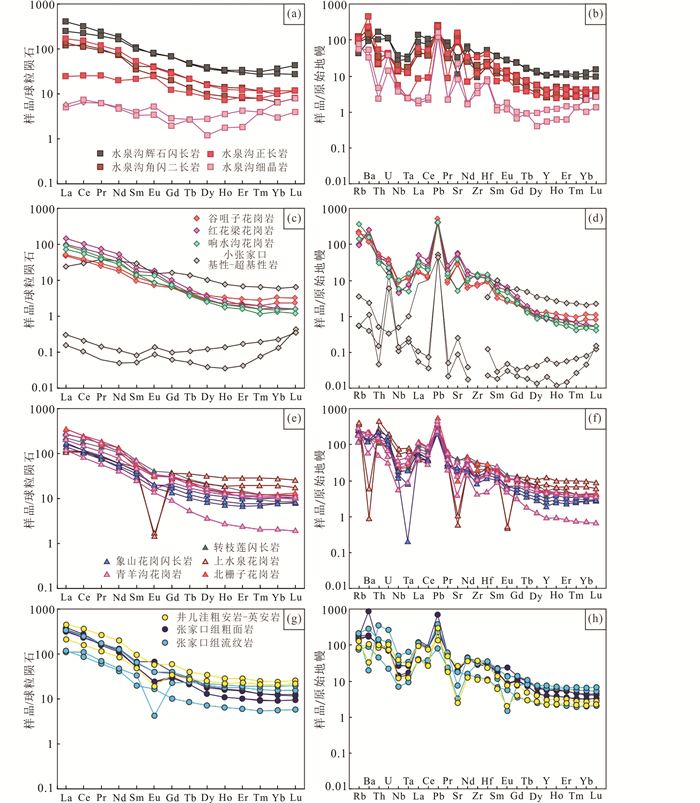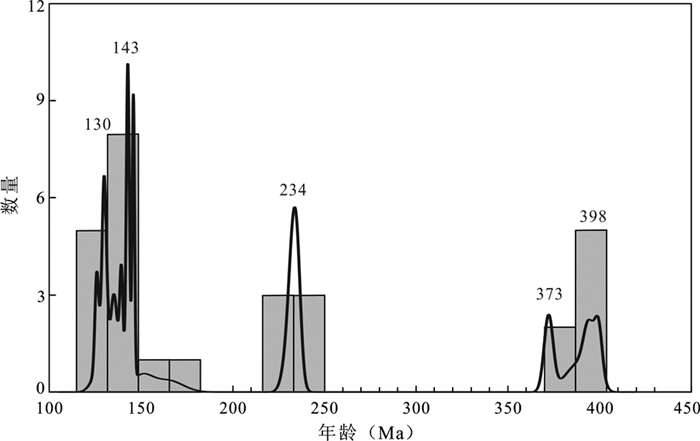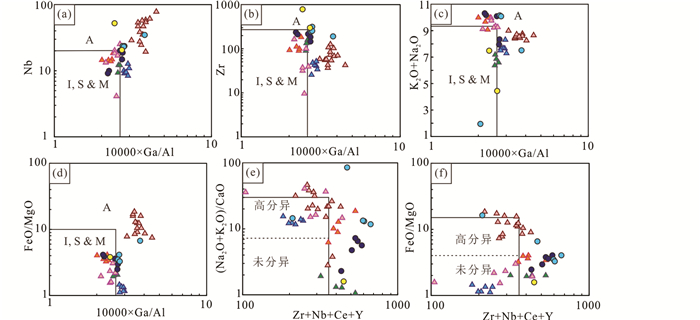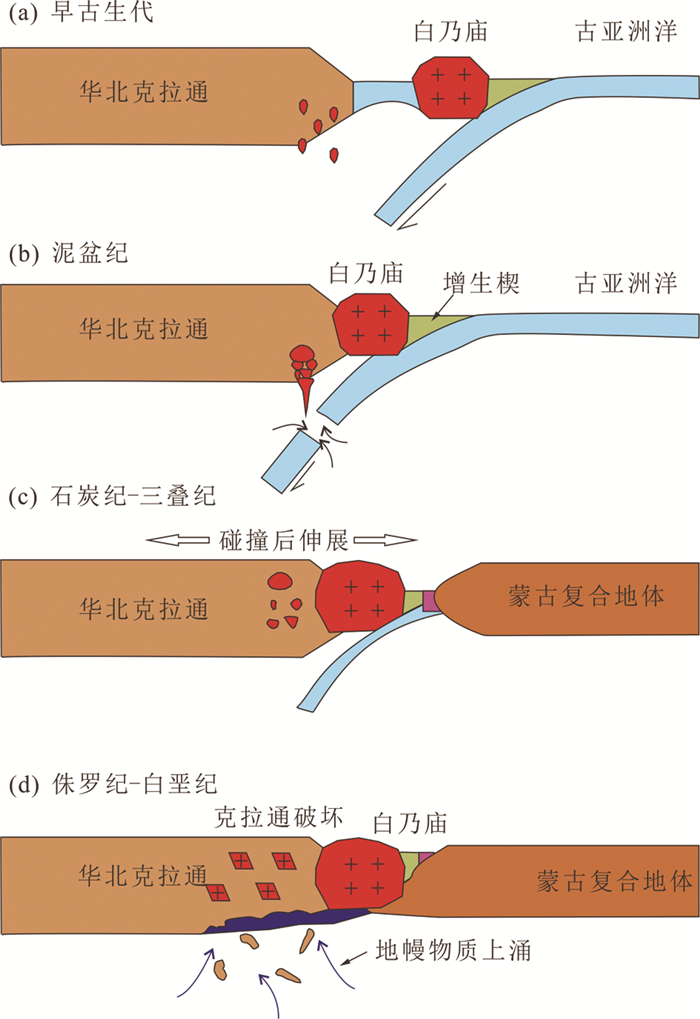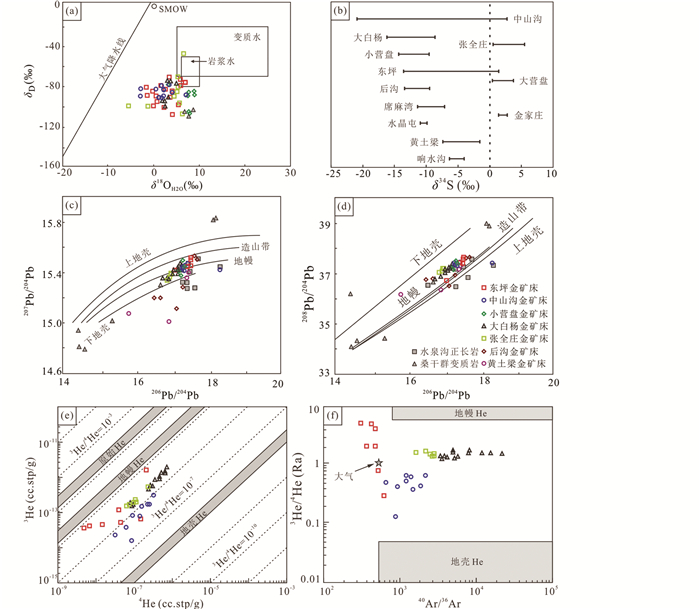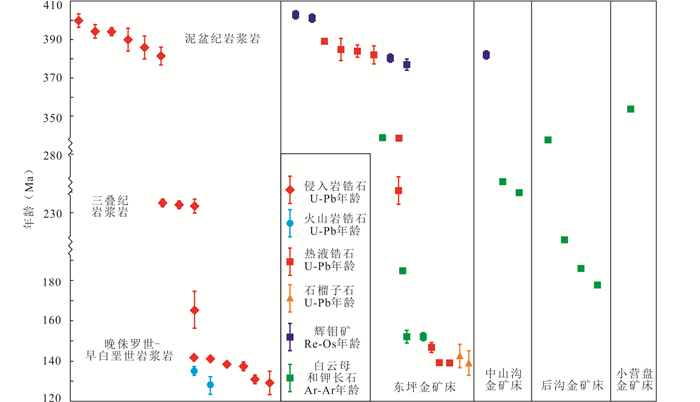|
Bao ZW, Zhao ZH, Zhang PH and Wang YX. 2003. REE, Sr, Nd, and Pb isotopic evidence for the petrogenesis of the Shuiquangou syenite complex in NW Hebei Province, China. Geological Review, 49(6): 596-604 (in Chinese with English abstract)
|
Bao ZW, Sun WD, Li CJ and Zhao ZH. 2014. U-Pb dating of hydrothermal zircon from the Dongping gold deposit in North China: Constraints on the mineralization processes. Ore Geology Reviews, 61: 107-119 DOI:10.1016/j.oregeorev.2014.02.006
|
Bao ZW, Li CJ and Zhao ZH. 2016. Metallogeny of the syenite-related Dongping gold deposit in the northern part of the North China Craton: A review and synthesis. Ore Geology Reviews, 73: 198-210 DOI:10.1016/j.oregeorev.2015.04.002
|
Burnard PG, Hu R, Turner G and Bi XW. 1999. Mantle, crustal and atmospheric noble gases in ailaoshan gold deposits, Yunnan Province, China. Geochimica et Cosmochimica Acta, 63(10): 1595-1604 DOI:10.1016/S0016-7037(99)00108-8
|
Cai MH, Peng ZA, Qu WJ, He ZY, Feng G, Zhang SQ, Xu M and Chen Y. 2011a. Geological characteristics and Re-Os dating of molybdenites in Chagandeersi molybdenum deposit, western Inner Mongolia. Mineral Deposits, 30(3): 377-384 (in Chinese with English abstract)
|
Cai MH, Zhang ZG, Qu WJ, Peng ZA, Zhang SQ, Xu M, Chen Y and Wang XB. 2011b. Geological characteristics and Re-Os dating of the Chaganhua molybdenum deposit in Urad Rear Banner, western Inner Mongolia. Acta Geoscientica Sinica, 32(1): 64-68 (in Chinese with English abstract)
|
Castillo PR, Janney PE and Solidum RU. 1999. Petrology and geochemistry of Camiguin Island, southern Philippines: Insights to the source of adakites and other lavas in a complex arc setting. Contributions to Mineralogy and Petrology, 134(1): 3351 DOI:10.1007/s004100050467
|
Chappell BW and White AJR. 1992. I- and S-type granites in the Lachlan Fold Belt. Earth and Environmental Science Transactions of The Royal Society of Edinburgh, 83(1-2): 1-26 DOI:10.1017/S0263593300007720
|
Chaussidon M and Lorand JP. 1990. Sulphur isotope composition of orogenic spinel lherzolite massifs from Ariege (North-Eastern Pyrenees, France): An ion microprobe study. Geochimica et Cosmochimica Acta, 54(10): 2835-2846 DOI:10.1016/0016-7037(90)90018-G
|
Chen B, Tian W and Liu AK. 2008. Petrogenesis of the Xiaozhangjiakou mafic-ultramafic complex, North Hebei: Constraints from petrological, geochemical and Nd-Sr isotopic data. Geological Journal of Chinese Universities, 14(3): 295-303 (in Chinese with English abstract)
|
Chen Q. 2013. Studies on fluid characteristics and mineralization mechanism of the Dabaiyang gold deposit, northwest of Hebei. Master Degree Thesis. Beijing: China University of Geosciences (Beijing) (in Chinese with English summary)
|
Cisse M, Lü XB, Algeo TJ, Cao XF, Li H, Wei M, Yuan Q and Chen M. 2017. Geochronology and geochemical characteristics of the Dongping ore-bearing granite, North China: Sources and implications for its tectonic setting. Ore Geology Reviews, 89: 1091-1106 DOI:10.1016/j.oregeorev.2016.07.006
|
Cook NJ, Ciobanu CL and Mao JW. 2009. Textural control on gold distribution in As-free pyrite from the Dongping, Huangtuliang and Hougou gold deposits, North China Craton (Hebei Province, China). Chemical Geology, 264(1-4): 101121
|
Dai JZ, Mao JW, Zhao CS, Xie GQ, Yang FQ and Wang YT. 2009. New U-Pb and Re-Os age data and the geodynamic setting of the Xiaojiayingzi Mo (Fe) deposit, western Liaoning Province, Northeastern China. Ore Geology Reviews, 35(2): 235-244 DOI:10.1016/j.oregeorev.2008.10.001
|
Decrée S, Demaiffe D, Tack L, Nimpagaritse G, De Paepe P, Boulvais P and Debaille V. 2019. The Neoproterozoic Upper Ruvubu alkaline plutonic complex (Burundi) revisited: Large-scale syntectonic emplacement, magmatic differentiation and late-stage circulations of fluids. Precambrian Research, 325: 150-171 DOI:10.1016/j.precamres.2019.02.023
|
Defant MJ and Drummond MS. 1990. Derivation of some modern arc magmas by melting of young subducted lithosphere. Nature, 347(6294): 662-665 DOI:10.1038/347662a0
|
Defant MJ and Drummond MS. 1993. Mount St. Helens: Potential example of the partial melting of the subducted lithosphere in a volcanic arc. Geology, 21(6): 547-550
|
Deng J and Wang QF. 2016. Gold mineralization in China: Metallogenic provinces, deposit types and tectonic framework. Gondwana Research, 36: 219-274 DOI:10.1016/j.gr.2015.10.003
|
DePaolo DJ. 1981. Trace element and isotopic effects of combined wallrock assimilation and fractional crystallization. Earth and Planetary Science Letters, 53(2): 189-202 DOI:10.1016/0012-821X(81)90153-9
|
|
Fan GH, Li JW, Deng XD, Gao WS and Li SY. 2021. Age and origin of the Dongping Au-Te deposit in the North China Craton revisited: Evidence from paragenesis, geochemistry, and in situ U-Pb geochronology of garnet. Economic Geology, 116(4): 963-985 DOI:10.5382/econgeo.4810
|
Fan HR, Xie YH and Zhai MG. 2001. Ore-forming fluids in the Dongping gold deposit, northwestern Hebei Province. Science in China (Series D), 44(8): 748-757 DOI:10.1007/BF02907204
|
Fan HR, Hu FF, Yang KF, Wang KY and Liu YS. 2009. Geochronology framework of Late Paleozoic dioritic-granitic plutons in the Bayan Obo area, Inner Mongolia, and tectonic significance. Acta Petrologica Sinica, 25(11): 2933-2938 (in Chinese with English abstract)
|
Fu FJ. 2007. The study of mineralization in Huangtuliang gold deposit, Northwest Hebei. Master Degree Thesis. Shijiazhuang: Shijiazhuang University of Economics (in Chinese with English summary)
|
Fu LB, Wei JH, Kusky TM, Chen HY, Tan J, Li YJ, Shi WJ, Chen C and Zhao SQ. 2012. The Cretaceous Duimiangou adakite-like intrusion from the Chifeng region, northern North China Craton: Crustal contamination of basaltic magma in an intracontinental extensional environment. Lithos, 134-135: 273-288 DOI:10.1016/j.lithos.2012.01.007
|
Gao S, Luo TC, Zhang BR, Zhang HF, Han YW, Zhao ZD and Hu YK. 1998. Chemical composition of the continental crust as revealed by studies in East China. Geochimica et Cosmochimica Acta, 62(11): 1959-1975 DOI:10.1016/S0016-7037(98)00121-5
|
Gao S, Rudnick RL, Yuan HL, Liu XM, Liu YS, Xu WL, Ling WL, Ayers J, Wang XC and Wang QH. 2004. Recycling lower continental crust in the North China craton. Nature, 432(7019): 892-897 DOI:10.1038/nature03162
|
Gao YF, Santosh M, Hou ZQ, Wei RH, Ma GX, Chen ZK and Wu JL. 2012. High Sr/Y magmas generated through crystal fractionation: Evidence from Mesozoic volcanic rocks in the northern Taihang orogen, North China Craton. Gondwana Research, 22(1): 152168
|
Han CM, Xiao WJ, Zhao GC, Sun M, Qu WJ and Du AD. 2009. A Re-Os study of molybdenites from the Lanjiagou Mo deposit of North China Craton and its geological significance. Gondwana Research, 16(2): 264-271 DOI:10.1016/j.gr.2009.01.001
|
Hart CJ, Goldfarb RJ, Qiu YM, Snee L, Miller LD and Miller ML. 2002. Gold deposits of the northern margin of the North China Craton: Multiple Late Paleozoic-Mesozoic mineralizing events. Mineralium Deposita, 37(3): 326-351 DOI:10.1007/s00126-001-0239-2
|
Hou WR. 2011. Constrast study on the Hadamengou gold deposit and Jinchanggouliang gold deposit, Inner Mongolia. Ph. D. Dissertation. Beijing: Chinese Academy of Geological Sciences (in Chinese with English summary)
|
Huang F, Li SG, Dong F, He YS and Chen FK. 2008. High-Mg adakitic rocks in the Dabie orogen, central China: Implications for foundering mechanism of lower continental crust. Chemical Geology, 255(1-2): 1-13 DOI:10.1016/j.chemgeo.2008.02.014
|
Huang WL and Wyllie PJ. 1981. Phase relationships of S-type granite with H 2O to 35kbar: Muscovite granite from Harney Peak, South Dakota. Journal of Geophysical Research: Solid Earth, 86(B11): 10515-10529 DOI:10.1029/JB086iB11p10515
|
Jian P, Liu DY, Kröner A, Windley BF, Shi YR, Zhang W, Zhang FQ, Miao LC, Zhang LQ and Tomurhuu D. 2010. Evolution of a Permian intraoceanic arc-trench system in the Solonker suture zone, Central Asian Orogenic Belt, China and Mongolia. Lithos, 118(1-2): 169-190 DOI:10.1016/j.lithos.2010.04.014
|
Jiang N. 2005. Petrology and geochemistry of the Shuiquangou syenitic complex, northern margin of the North China Craton. Journal of the Geological Society, 162(1): 203-215 DOI:10.1144/0016-764903-144
|
Jiang N. 2006. Hydrothermal alteration of chevkinite-(Ce) in the Shuiquangou syenitic intrusion, northern China. Chemical Geology, 227(1-2): 100-112 DOI:10.1016/j.chemgeo.2005.09.004
|
Jiang N, Liu YS, Zhou WG, Yang JH and Zhang SQ. 2007. Derivation of Mesozoic adakitic magmas from ancient lower crust in the North China craton. Geochimica et Cosmochimica Acta, 71(10): 2591-2608 DOI:10.1016/j.gca.2007.02.018
|
Jiang N, Zhang SQ, Zhou WG and Liu YS. 2009. Origin of a Mesozoic granite with A-type characteristics from the North China craton: Highly fractionated from I-type magmas?. Contributions to Mineralogy and Petrology, 158(1): 113-130 DOI:10.1007/s00410-008-0373-2
|
Jiang SH and Nie FJ. 1998. A comparison study on geological and geochemical features and ore genesis of the Xiaoyingpan and Dongping gold deposits, Hebei. Gold Geology, 4(4): 12-24 (in Chinese with English abstract)
|
Jiang SH and Nie FJ. 2000. 40Ar/39Ar geochronology of the Shuiquangou alkaline complex and related gold deposits, northwestern Hebei, China. Geological Review, 46(6): 621-627 (in Chinese with English abstract)
|
Jiang SH, Zhang LL, Liu YF, Liu CH, Kang H and Wang FX. 2018. Metallogeny of Xing-Meng Orogenic Belt and some related problems. Mineral Deposits, 37(4): 671-711 (in Chinese with English abstract)
|
Jiang YH, Jiang SY, Zhao KD, Ni P, Ling HF and Liu DY. 2005. SHRIMP U-Pb zircon dating for lamprophyre from Liaodong Peninsula: Constraints on the initial time of Mesozoic lithosphere thinning beneath eastern China. Chinese Science Bulletin, 50(22): 2612-2620 DOI:10.1360/982005-373
|
Li CJ and Bao ZW. 2012. Geochemical characteristics and geodynamic implications of the Early Cretaceous magmatisms in Zhangjiakou region, northwest Hebei Province, China. Geochimica, 41(4): 343-358 (in Chinese with English abstract)
|
Li CM, Deng JF, Chen LH, Su SG, Li HM, Hu SL and Liu XM. 2010a. Two periods of zircon from Dongping gold deposit in Zhangjiakou-Xuanhua area, northern margin of North China: Constraints on metallogenic chronology. Mineral Deposits, 29(2): 265-275
|
Li CM, Deng JF, Su SG, Li HM and Liu XM. 2010b. Two stage zircon U-Pb ages of the potash altered rock in the Dongping gold deposit, Hebei Province, and their geological implications. Acta Geoscientica Sinica, 31(6): 843-852 (in Chinese with English abstract)
|
Li CM, Deng JF., Su SG, Liu C and Liu XM. 2014. Zircon U-Pb chronology and Hf isotope in the western part of the Shuiquangou alkaline complex, northern Hebei Province. Acta Petrologica Sinica, 30(11): 3301-3314 (in Chinese with English abstract)
|
Li H, Li JW, Algeo TJ, Wu JH and Cisse M. 2018. Zircon indicators of fluid sources and ore genesis in a multi-stage hydrothermal system: The Dongping Au deposit in North China. Lithos, 314-315: 463478
|
Li R. 1992. Geological-geochemical features and metallogenic pattern of the Hougou gold deposit. Geology and Exploration, (3): 46-50 (in Chinese with English abstract)
|
Li SZ and Jin GC. 2000. Geological characteristics and structural ore-controlling role of the Dongping gold deposit, Hebei Province. Acta Geoscientia Sinica, 21(1): 44-51 (in Chinese with English abstract)
|
Li WB, Zhong RC, Xu C, Song B and Qu WJ. 2012. U-Pb and Re-Os geochronology of the Bainaimiao Cu-Mo-Au deposit, on the northern margin of the North China Craton, Central Asia Orogenic Belt: Implications for ore genesis and geodynamic setting. Ore Geology Reviews, 48: 139-150 DOI:10.1016/j.oregeorev.2012.03.001
|
Li XY, Fan WM, Guo F, Wang YJ and Li CW. 2004. Modification of the lithospheric mantle beneath the northern North China Block by the Paleo-Asian Ocean: Geochemical evidence from mafic volcanic rocks of the Nandaling Formation in the Xishan area, Beijing. Acta Petrologica Sinica, 20(3): 557-566 (in Chinese with English abstract)
|
Li YL, Zhou HW, Brouwer FM, Xiao WJ, Wijbrans JR and Zhong ZQ. 2014. Early Paleozoic to Middle Triassic bivergent accretion in the Central Asian Orogenic Belt: Insights from zircon U-Pb dating of ductile shear zones in central Inner Mongolia, China. Lithos, 205: 84-111 DOI:10.1016/j.lithos.2014.06.017
|
Liu CH and Nie FJ. 2015. Permian magmatic sequences of the Bilihe gold deposit in central Inner Mongolia, China: Petrogenesis and tectonic significance. Lithos, 231: 3552
|
Liu DY, Geng YS and Song B. 1997. Late Archean crustal accetion and reworking in northwestern Hebei Province: Isochronology evidence. Acta Geoscientia Sinica, 18(3): 226-232 (in Chinese with English abstract)
|
Liu HT. 1999. Analysis of ore controlling factors of Huangtuliang gold deposit, Northwest Hebei Province. Journal of Precious Metallic Geology, 8(4): 209-216 (in Chinese with English abstract)
|
Liu Q, Zhao GC, Sun M, Han YG, Eizenhofer PR, Hou WZ, Zhang XR, Zhu YL, Wang B, Liu DX and Xu B. 2016. Early Paleozoic subduction processes of the Paleo-Asian Ocean: Insights from geochronology and geochemistry of Paleozoic plutons in the Alxa Terrane. Lithos, 262: 546-560 DOI:10.1016/j.lithos.2016.07.041
|
Liu Y, Liu HC and Li XH. 1996. Simultaneous and precise determination of 40 trace elements in rock samples using ICP-MS. Geochimica, 25(6): 552-558 (in Chinese with English abstract)
|
Liu YF, Nie FJ, Jiang SH, Hou WR, Liang QL, Zhang K and Liu Y. 2012. Geochronology of Zhunsujihua molybdenum deposit in Sonid Left Banner, Inner Mongolia, and its geological significance. Mineral Deposits, 31(1): 119-128 (in Chinese with English abstract)
|
Liu YF and Jiang SH. 2017. Mo mineralization in Xing'an-Mongolian orogen and north margin of Chinacraton: Review, question and a preliminary genetic model. Mineral Deposits, 36(3): 557-594 (in Chinese with English abstract)
|
Liu YS, Hu ZC, Gao S, Günther D, Xu J, Gao CG and Chen HH. 2008. In situ analysis of major and trace elements of anhydrous minerals by LA-ICP-MS without applying an internal standard. Chemical Geology, 257(1-2): 34-43 DOI:10.1016/j.chemgeo.2008.08.004
|
Liu YS, Gao S, Hu ZC, Gao CG, Zong KQ and Wang DB. 2010. Continental and oceanic crust recycling-induced melt-peridotite interactions in the Trans-North China Orogen: U-Pb dating, Hf isotopes and trace elements in zircons from mantle xenoliths. Journal of Petrology, 51(1-2): 537-571 DOI:10.1093/petrology/egp082
|
Lu DL, Luo XQ, Wang JJ, Zhang SH and Zheng BY. 1993. The metallogenic epoch of the Dongping gold deposit. Mineral Deposits, 12(2): 182-188 (in Chinese with English abstract)
|
Lu FX, Zheng JP, Shao JA, Zhang RS, Chen MH and Yu CM. 2006. Asthenospheric upwelling and lithospheric thinning in late Cretaceous-Cenozoic in eastern North China. Earth Science Frontiers, 13(2): 86-92 (in Chinese with English abstract)
|
Ludwig KR. 2003. User's Manual for Isoplot 3.00: A Geochronological Toolkit for Microsoft Excel. Berkeley: Berkeley Geochronology Center
|
Luo ZK, Miao LC and Guan K. 2000. Discussion on the metallogenetic epoch of gold deposit on north fringe of North China platform. Gold Geology, 6(2): 70-76 (in Chinese with English abstract)
|
Ma Q, Zheng JP, Xu YG, Griffin WL and Zhang RS. 2015. Are continental "adakites" derived from thickened or foundered lower crust?. Earth and Planetary Science Letters, 419: 125-133 DOI:10.1016/j.epsl.2015.02.036
|
Ma YS, Cui SQ, Zhao Y, Zeng QL and Wu ML. 2002. The transformation process of Mesozoic-cenozoic tectonic regime in the north of North China. Journal of Geomechanics, 8(1): 15-25 (in Chinese with English abstract)
|
Mao JW, Li YQ, Goldfarb R, He Y and Zaw K. 2003. Fluid inclusion and noble gas studies of the Dongping gold deposit, Hebei Province, China: A mantle connection for mineralization?. Economic Geology, 98(3): 517-534
|
Mao JW, Wang YT, Zhang ZH, Yu JJ and Niu BG. 2003. Geodynamic settings of Mesozoic large-scale mineralization in North China and adjacent areas: Implication from the highly precise and accurate ages of metal deposits. Science in China (Series D), 46(8): 838-851
|
Mao JW, Xie GQ, Zhang ZH, Li XF, Wang YT, Zhang CQ and Li YF. 2005. Mesozoic large-scale metallogenic pulses in North China and corresponding geodynamic setting. Acta Petrologica Sinica, 21(1): 169-188 (in Chinese with English abstract)
|
Mark DF, Stuart FM and de Podesta M. 2011. New high-precision measurements of the isotopic composition of atmospheric argon. Geochimica et Cosmochimica Acta, 75(23): 74947501
|
Martin H, Smithies RH, Rapp R, Moyen JF and Champion D. 2005. An overview of adakite, tonalite-trondhjemite-granodiorite (TTG), and sanukitoid: Relationships and some implications for crustal evolution. Lithos, 79(1-2): 1-24 DOI:10.1016/j.lithos.2004.04.048
|
Miao LC, Qiu YM, McNaughton N, Luo ZK, Groves D, Zhai YS, Fan WM, Zhai MG and Guan K. 2002. SHRIMP U-Pb zircon geochronology of granitoids from Dongping area, Hebei Province, China: Constraints on tectonic evolution and geodynamic setting for gold metallogeny. Ore Geology Reviews, 19(3-4): 187-204 DOI:10.1016/S0169-1368(01)00041-5
|
|
Nie FJ. 1998. Geology and origin of the Dongping alkalic-type gold deposit, Northern Hebei province, People's Republic of China. Resource Geology, 48(3): 139-158 DOI:10.1111/j.1751-3928.1998.tb00013.x
|
Ohmoto H. 1972. Systematics of sulfur and carbon isotopes in hydrothermal ore deposits. Economic Geology, 67(5): 551-578 DOI:10.2113/gsecongeo.67.5.551
|
Riishuus MS, Peate DW, Tegner C, Wilson JR, Brooks CK and Waight TE. 2005. Petrogenesis of syenites at a rifted continental margin: Origin, contamination and interaction of alkaline mafic and felsic magmas in the Astrophyllite Bay Complex, East Greenland. Contributions to Mineralogy and Petrology, 149(3): 350-371 DOI:10.1007/s00410-005-0655-x
|
Scherbarth NL and Spry PG. 2006. Mineralogical, petrological, stable isotope, and fluid inclusion characteristics of the Tuvatu gold-silver telluride deposit, Fiji: Comparisons with the emperor deposit. Economic Geology, 101(1): 135-158 DOI:10.2113/gsecongeo.101.1.135
|
Shangguan S, Peate IU, Tian W and Xu Y. 2016. Re-evaluating the geochronology of the Permian Tarim magmatic province: Implications for temporal evolution of magmatism. Journal of the Geological Society, 173(1): 228-239 DOI:10.1144/jgs2014-114
|
Shao JA, He GQ and Tang KD. 2015. The evolution of Permian continental crust in northern part of North China. Acta Petrologica Sinica, 31(1): 47-55 (in Chinese with English abstract)
|
Shen JF, Santosh M, Li SR., Li CP, Zhang JQ, Zhang SQ, Alam M, Wang YH and Xu KX. 2020. He-Ar, S, Pb and O isotope geochemistry of the Dabaiyang gold deposit: Implications for the relationship between gold metallogeny and destruction of the North China Craton. Ore Geology Reviews, 116: 103229 DOI:10.1016/j.oregeorev.2019.103229
|
Shi LS, Rao YX, Song RX and Wen JH. 2007. Geological characteristics of isotopes and inclusions in gold accumulated area of Zhangjiakou, Hebei Province. Mineral Resources and Geology, 21(3): 219-227 (in Chinese with English abstract)
|
Shi YR, Liu DY, Miao LC, Zhang FQ, Jian P, Zhang W, Hou KJ and Xu JY. 2010. Devonian A-type granitic magmatism on the northern margin of the North China Craton: SHRIMP U-Pb zircon dating and Hf-isotopes of the Hongshan granite at Chifeng, Inner Mongolia, China. Gondwana Research, 17(4): 632641
|
Song GR and Zhao ZH. 1996. Geology of Dongping Alkaline Complex-Hosted Gold Deposit in Hebei Province. Beijing: Seismological Press (in Chinese with English abstract)
|
Song RX, Wei MH and Wang JS, et al. 2013. Geology and Ores in the Zhangjiakou District. Beijing: Geological Publishing House (in Chinese)
|
Song Y, Jiang SH, Bagas L, Li C, Hu JZ, Zhang Q, Zhou W and Ding HY. 2016. The geology and geochemistry of Jinchangyu gold deposit, North China Craton: Implications for metallogenesis and geodynamic setting. Ore Geology Reviews, 73: 313-329 DOI:10.1016/j.oregeorev.2014.10.031
|
Spry PG, Paredes MM, Foster F, Truckle JS and Chadwick TH. 1996. Evidence for a genetic link between gold-silver telluride and porphyry molybdenum mineralization at the Golden Sunlight deposit, Whitehall, Montana: Fluid inclusion and stable isotope studies. Economic Geology, 91(3): 507-526 DOI:10.2113/gsecongeo.91.3.507
|
Stern RA and Hanson GN. 1991. Archean high-Mg granodiorite: A derivative of light rare earth element enriched monzodiorite of mantle origin. Journal of Petrology, 32(1): 201238
|
Stuart FM, Burnard PG, Taylor RP and Turner G. 1995. Resolving mantle and crustal contributions to ancient hydrothermal fluids: He-Ar isotopes in fluid inclusions from Dae Hwa W-Mo mineralisation, South Korea. Geochimica et Cosmochimica Acta, 59(22): 46634673
|
Sun JF and Yang JH. 2009. Early Cretaceous A-type granites in the Eastern North China Block with relation to destruction of the craton. Earth Science (Journal of China University of Geosciences), 34(1): 137-147 (in Chinese with English abstract) DOI:10.3799/dqkx.2009.013
|
Sun SS and McDonough WF. 1989. Chemical and isotopic systematics of oceanic basalts: Implications for mantle composition and processes. In: Saunders AD and Norry MJ (eds.). Magmatism in the Ocean Basins. Geological Society, London, Special Publications, 42(1): 313-345 DOI:10.1144/GSL.SP.1989.042.01.19
|
Sutcliffe RH, Smith AR, Doherty W and Barnett RL. 1990. Mantle derivation of Archean Amphibole-bearing granitoid and associated mafic rocks: Evidence from the Southern Superior Province, Canada. Contributions to Mineralogy and Petrology, 105(3): 255-274 DOI:10.1007/BF00306538
|
Tao LX, Zhen SM, Bai HJ, Wang J, Wang DZ and Zha ZJ. 2020. Pyrite trace element composition and S-Pb isotope characters of the Dabaiyang gold deposit, Hebei Province. Journal of Jilin University (Earth Science Edition), 50(5): 1582-1598 (in Chinese with English abstract)
|
Tian W, Chen B, Liu CQ and Zhang HF. 2007. Zircon U-Pb age and Hf isotopic composition of the Xiaozhangjiakou ultramafic pluton in northern Hebei. Acta Petrologica Sinica, 23(3): 583-590 (in Chinese with English abstract)
|
Vernon RH. 2004. A Practical Guide to Rock Microstructure. New York: Cambridge University Press
|
Wang DZ, Liu JJ, Zhai DG, Carranza EJM, Wang YH, Zhen SM, Wang J, Wang JP, Liu ZJ and Zhang FF. 2019a. Mineral paragenesis and ore-forming processes of the Dongping gold deposit, Hebei Province, China. Resource Geology, 69(3): 287-313 DOI:10.1111/rge.12202
|
Wang DZ, Liu JJ, Zhai DG, Zhen SM, Wang J and Yang XA. 2019b. New discovery of molybdenite in the Dongping gold deposit, Hebei province, China and its Re-Os geochronological implications. Acta Geologica Sinica, 93(3): 769-770 DOI:10.1111/1755-6724.13841
|
Wang DZ, Liu JJ, Zhai DG, de Fourestier J, Wang YH, Zhen SM, Wang JP, Liu ZJ and Zhang FF. 2020. Textures and formation of microporous gold in the Dongping gold deposit, Hebei Province, China. Ore Geology Reviews, 120: 103437 DOI:10.1016/j.oregeorev.2020.103437
|
Wang DZ, Liu JJ, Zhai DG, Zhen SM and Wang J. 2020. Study on molybdenite Re-Os and zircon U-Pb ages of the Dongping tellurium-gold deposit in Hebei Province. Earth Science Frontiers, 27(2): 405-419 (in Chinese with English abstract)
|
Wang DZ, Zhen SM, Liu JJ, Carranza EJM, Wang J, Zha ZJ, Li YS and Bai HJ. 2021. Mineral paragenesis and hydrothermal evolution of the Dabaiyang tellurium-gold deposit, Hebei Province, China: Constraints from fluid inclusions, H-O-He-Ar isotopes, and physicochemical conditions. Ore Geology Reviews, 130: 103904 DOI:10.1016/j.oregeorev.2020.103904
|
Wang JP, Liu YS, Dong XF, Li ZJ, Peng H, Wang LJ, Ding YC, Yang YD, Meng XG, Jia HJ, Liu ZB, Liu JM and Wang HC. 1992. Study on Ore-Controlling Tectonics of Jinchanggouliang Gold Deposit, Inner Mongolia. Beijing: Geological Publishing House (in Chinese with English abstract)
|
Wang L, Wang GH, Lei SB, Chang CJ, Hou WR, Jia LQ, Zhao GM and Chen HJ. 2015. Re-Os dating of molybdenites from the Houshihua gold deposit in Wuchuan County, Inner Mongolia and its geological significance. Geology and Exploration, 51(3): 422-431 (in Chinese with English abstract)
|
Wang SL. 1986. Study of the genesis of Zhangjiakou gold deposit. Acta Scientiarum Naturalium, Universitatis Pekinensis, (4): 81-89 (in Chinese with English abstract)
|
Wang Y, Jiang XM and Wang ZK. 1990. Characteristics of lead and sulfur isorope of the gold deposits in Zhangjiakou Xuanhua area Hebei Province. Contributions to Geology and Mineral Resources Research, 5(2): 66-75 (in Chinese with English abstract)
|
Wang ZK, Jiang XM, Wang Y and Shang MY. 1992. A comparative analysis on geological-geochemical features of the Xiaoyingpan and Dongping gold deposits, Hebei. Geology and Exploration, (7): 14-20 (in Chinese with English abstract)
|
Wei ZL, Zhang H, Liu XM and Zhang YQ. 2008. LA-ICP-MS dating and geological meaning of the Zhangjiakou Formation volcanic rocks, Zhangjiakou area. Progress in Natural Science, 18(5): 523-530 (in Chinese) DOI:10.1016/j.pnsc.2007.12.005
|
Whalen JB, Currie KL and Chappell BW. 1987. A-type granites: Geochemical characteristics, discrimination and petrogenesis. Contributions to Mineralogy and Petrology, 95(4): 407-419 DOI:10.1007/BF00402202
|
Windley BF, Alexeiev D, Xiao WJ, Kroner A and Badarch G. 2007. Tectonic models for accretion of the Central Asian Orogenic Belt. Journal of the Geological Society, 164: 31-47 DOI:10.1144/0016-76492006-022
|
Wu FY, Xu YG, Gao S and Zheng JP. 2008. Lithospheric thinning and destruction of the North China Craton. Acta Petrologica Sinica, 24(6): 1145-1174 (in Chinese with English abstract)
|
Wu FY, Liu XC, Ji WQ, Wang JM and Yang L. 2017. Highly fractionated granites: Recognition and research. Science China (Earth Sciences), 60(7): 1201-1219 DOI:10.1007/s11430-016-5139-1
|
Wu SS. 2009. Research on ore-formation and ore-controlling structure of Zhongshangou gold deposit in Chongli County, Hebei Province. Master Degree Thesis. Shijiazhuang: Shijiazhuang University of Economics (in Chinese with English summary)
|
Wyllie PJ and Sekine T. 1982. The formation of mantle phlogopite in subduction zone hybridization. Contributions to Mineralogy and Petrology, 79(4): 375-380 DOI:10.1007/BF01132067
|
Xiao WJ, Windley BF, Hao J and Zhai MG. 2003. Accretion leading to collision and the Permian Solonker suture, Inner Mongolia, China: Termination of the central Asian orogenic belt. Tectonics, 22(6): 1069
|
Xu YG, Li HY, Pang CJ and He B. 2009. On the timing and duration of the destruction of the North China Craton. Chinese Science Bulletin, 54(19): 3379-3396
|
Yang F, Santosh M, Kim SW, Zhou HY and Jeong YJ. 2020. Late Mesozoic intraplate rhyolitic volcanism in the North China Craton: Far-field effect of the westward subduction of the Paleo-Pacific Plate. Geological Society of America Bulletin, 132(1-2): 291-309 DOI:10.1130/B35123.1
|
Yang JH, Wu FY, Chung SL, Wilde SA, Chu MF, Lo CH and Song B. 2005. Petrogenesis of Early Cretaceous intrusions in the Sulu ultrahigh-pressure orogenic belt, East China and their relationship to lithospheric thinning. Chemical Geology, 222(34): 200231
|
Yang JH, Wu FY, Liu XM and Xie LW. 2005. Zircon U-Pb ages and Hf isotopes and their geological significance of the Miyun rapakivi granites from Beijing, China. Acta Petrologica Sinica, 21(6): 1633-1644 (in Chinese with English abstract)
|
Yang JH, Wu FY, Shao JA, Xie LW and Liu XM. 2006. In-situ U-Pb dating and Hf isotopic analyses of zircons from volcanic rocks of the Houcheng and Zhangjiakou Formations in the Zhang-Xuan area, Northeast China. Earth Science (Journal of China University of Geosciences), 31(1): 71-80 (in Chinese with English abstract)
|
Yang ZM, Chang ZS, Hou ZQ and Meffre S. 2016. Age, igneous petrogenesis, and tectonic setting of the Bilihe gold deposit, China, and implications for regional metallogeny. Gondwana Research, 34: 296314
|
Yin JZ and Shi HY. 1995. Geology of Gold Ore Deposits in Zhangjiakou-Xuanhua Region, Hebei Province, China. Beijing: Geological Publishing House (in Chinese)
|
Yu B, Zeng QD, Frimmel HE, Qiu HC, Li QL, Yang JH, Wang YB, Zhou LL, Chen PW and Li JP. 2020. The 127Ma gold mineralization in the Wulong deposit, Liaodong Peninsula, China: Constraints from molybdenite Re-Os, monazite U-Th-Pb, and zircon U-Pb geochronology. Ore Geology Reviews, 121: 103542 DOI:10.1016/j.oregeorev.2020.103542
|
Zeng QD, Liu JM, Zhang ZL, Qin F, Chen WJ, Zhang RB, Yu CM and Ye J. 2009. Ore-forming time of the Jiguanshan porphyry molybdenum deposit, northern margin of North China Craton and the Indosinian mineralization. Acta Petrologica Sinica, 25(2): 393-398 (in Chinese with English abstract)
|
Zeng QD, Sun Y, Duan XX and Liu JM. 2013. U-Pb and Re-Os geochronology of the Haolibao porphyry Mo-Cu deposit, NE China: Implications for a Late Permian tectonic setting. Geological Magazine, 150(6): 975-985 DOI:10.1017/S0016756813000186
|
Zeng QD, Wang YB, Yang JH, Guo YP, Yu B, Zhou LL and Qiu HC. 2021. Spatial-temporal distribution and tectonic setting of gold deposits in the northern margin gold belt of the North China Craton. International Geology Review, 63(8): 941-972 DOI:10.1080/00206814.2020.1737839
|
|
Zhai MG. 2010. Tectonic evolution and metallogenesis of North China Craton. Mineral Deposits, 29(1): 24-36 (in Chinese with English abstract)
|
Zhang C, Ma CQ and Holtz F. 2012. Partial melting of hydrous lower continental crust: Discussion on the petrogenesis of C-type adakites from the Dabie Orogen. Geological Journal of China Universities, 18(1): 41-51 (in Chinese with English abstract)
|
Zhang C, Guo W, Xu ZY, Liu ZH, Liu YJ and Lei CC. 2014. Study on geochronology, petrogenesis and tectonic implications of monzogranite from the Yanbian area, eastern Jilin Province. Acta Petrologica Sinica, 30(2): 512-526 (in Chinese with English abstract)
|
Zhang LL, Jiang SH, Li HM, Wu D and Kang H. 2019. Metallogenic and petrogenic geochronology and geochemical features of the ore-related granite in the Sadaigoumen Mo Deposit, Fengning, Hebei Province. Acta Geoscientica Sinica, 40(5): 708-724 (in Chinese with English abstract)
|
Zhang QQ, Zhang SH, Zhao Y and Liu JM. 2018. Devonian alkaline magmatic belt along the northern margin of the North China Block: Petrogenesis and tectonic implications. Lithos, 302-303: 496-518 DOI:10.1016/j.lithos.2018.01.019
|
Zhang SH, Zhao Y, Song B and Liu DY. 2007. Petrogenesis of the Middle Devonian Gushan diorite pluton on the northern margin of the North China block and its tectonic implications. Geological Magazine, 144(3): 553-568 DOI:10.1017/S0016756807003275
|
Zhang SH, Zhao Y, Kröner A, Liu XM, Xie LW and Chen FK. 2009a. Early Permian plutons from the northern North China Block: Constraints on continental arc evolution and convergent margin magmatism related to the Central Asian Orogenic Belt. International Journal of Earth Sciences, 98(6): 1441-1467 DOI:10.1007/s00531-008-0368-2
|
Zhang SH, Zhao Y, Liu XC, Liu DY, Ch en, F K, Xie LW and Chen HH. 2009b. Late Paleozoic to Early Mesozoic mafic-ultramafic complexes from the northern North China Block: Constraints on the composition and evolution of the lithospheric mantle. Lithos, 110(1-4): 229-246 DOI:10.1016/j.lithos.2009.01.008
|
Zhang SH, Zhao Y, Song B, Hu JM, Liu SW, Yang YH, Chen FK, Liu XM and Liu J. 2009c. Contrasting Late Carboniferous and Late Permian-Middle Triassic intrusive suites from the northern margin of the North China craton: Geochronology, petrogenesis, and tectonic implications. Geological Society of America Bulletin, 121(1-2): 181-200
|
Zhang SH, Zhao Y, Ye H, Hou KJ and Li CF. 2012. Early Mesozoic alkaline complexes in the northern North China Craton: Implications for cratonic lithospheric destruction. Lithos, 155: 1-18 DOI:10.1016/j.lithos.2012.08.009
|
Zhang SH, Zhao Y, Ye H, Liu JM and Hu ZC. 2014a. Origin and evolution of the Bainaimiao arc belt: Implications for crustal growth in the southern Central Asian orogenic belt. Geological Society of America Bulletin, 126(9-10): 1275-1300 DOI:10.1130/B31042.1
|
Zhang SH, Zhao Y, Davis GA, Ye H and Wu F. 2014b. Temporal and spatial variations of Mesozoic magmatism and deformation in the North China Craton: Implications for lithospheric thinning and decratonization. Earth-Science Reviews, 131: 49-87 DOI:10.1016/j.earscirev.2013.12.004
|
Zhang T, Chen ZY, Xu LQ and Chen ZH. 2009. The Re-Os isotopic dating of molybdenite from the Dasuji molybdenum deposit in Zhuozi County of Inner Mongolia and its geological significance. Rock and Mineral Analysis, 28(3): 279-282 (in Chinese with English abstract)
|
Zhang XH and Zhai MG. 2010. Magmatism and its metallogenetic effects during the Paleozoic continental crustal construction in northern North China: An overview. Acta Petrologica Sinica, 26(5): 1329-1341 (in Chinese with English abstract)
|
Zhang XH, Zhang HF, Jiang N, Zhai MG and Zhang YB. 2010. Early Devonian alkaline intrusive complex from the northern North China craton: A petrological monitor of post-collisional tectonics. Journal of the Geological Society, 167(4): 717-730 DOI:10.1144/0016-76492009-110
|
Zhang YM, Gu XX, Xiang ZL, Liu RP, Cheng WB and Wang XL. 2017. Magmatic hydrothermal origin of the Hadamengou-Liubagou Au-Mo deposit, Inner Mongolia, China: Constrains on geology, stable and Re-Os isotopes. Ore Geology Reviews, 86: 172-195 DOI:10.1016/j.oregeorev.2017.01.029
|
Zhang ZC. 1995. Origin of Shuiquangou complex in Northern Hebei Province and a study of its relation to the gold mineralization. Ph. D. Dissertation. Beijing: Chinese Academy of Geological Sciences (in Chinese with English summary)
|
Zhang ZC and Mao JW. 1995. Geology and geochemistry of the Dongping gold telluride deposit, Heibei Province, North China. International Geology Review, 37(12): 1094-1108 DOI:10.1080/00206819509465441
|
Zhang ZC and Chen HX. 1997. Geology and petrology of Shuiquangou complex, northern Hebei Province. 6(2): 81-92 (in Chinese with English abstract)
|
Zhao GC, Wilde SA, Li SZ, Sun M, Grant ML and Li XP. 2007. U-Pb zircon age constraints on the Dongwanzi ultramafic-mafic body, North China, confirm it is not an Archean ophiolite. Earth and Planetary Science Letters, 255(1-2): 85-93 DOI:10.1016/j.epsl.2006.12.007
|
Zhao GC and Zhai MG. 2013. Lithotectonic elements of Precambrian basement in the North China Craton: Review and tectonic implications. Gondwana Research, 23(4): 1207-1240 DOI:10.1016/j.gr.2012.08.016
|
Zhao Y, Zhai MG, Chen H and Zhang SH. 2017. Paleozoic-early Jurassic tectonic evolution of North China Craton and its adjacent orogenic belts. Geology in China, 44(1): 44-60 (in Chinese with English abstract)
|
Zhao ZH, Bao ZW and Qiao YL. 2010. A peculiar composite M- and W-type REE tetrad effect: Evidence from the Shuiquangou alkaline syenite complex, Hebei Province, China. Chinese Science Bulletin, 55(22): 2684-2696
|
Zhen SM, Wang QF, Wang DZ, Carranza EJM, Liu J, Pang Z, Cheng Z, Xue J, Wang J and Zha ZJ. 2020. Genesis of the Zhangquanzhuang gold deposit in the northern margin of North China Craton: constraints from deposit geology and ore isotope geochemistry. Ore Geology Reviews, 122: 103511 DOI:10.1016/j.oregeorev.2020.103511
|
Zhen SM, Zha ZJ, Wang DZ, Liu JJ, Pang ZS, Cheng ZZ, Xue JL, Wang J, Bai HJ, Li Y, Chen C. 2021. Characteristics of ore-forming fluids of the Zhongshangou gold deposit, Zhangjiakou-Xuanhua area, Hebei Province, and its limitation on the intrusive rock related telluride-gold deposits. Geology in China: 1-27 (in Chinese with English abstract)
|
Zhu RX, Chen L, Wu FY and Liu JL. 2011. Timing, scale and mechanism of the destruction of the North China Craton. Science China (Earth Sciences), 54(6): 789-797 DOI:10.1007/s11430-011-4203-4
|
|
|
|
|
|
陈茜. 2013. 冀西北大白阳金矿成矿流体及成矿机制研究. 硕士学位论文. 北京: 中国地质大学(北京)
|
|
付方建. 2007. 冀西北黄土梁金矿成矿规律研究. 硕士学位论文. 石家庄: 石家庄经济学院
|
侯万荣. 2011. 内蒙古哈达门沟金矿床与金厂沟梁金矿床对比研究. 博士学位论文. 北京: 中国地质科学院
|
|
|
|
|
|
|
|
|
|
|
|
|
|
|
|
|
|
|
|
|
|
|
|
|
宋国瑞, 赵振华. 1996. 河北省东坪碱性杂岩金矿地质. 北京: 地震出版社.
|
宋瑞先, 魏明辉, 王金锁, 等. 2013. 张家口地质矿产. 北京: 地质出版社.
|
|
|
|
|
王建平, 刘永山, 董法先, 李中坚, 彭华, 王连捷, 丁原辰, 杨玉东, 孟宪刚, 贾宏杰, 刘志斌, 刘建民, 王红才. 1992. 内蒙古金厂沟梁金矿构造控矿分析. 北京: 地质出版社.
|
|
|
|
|
|
|
|
吴姗姗. 2009. 河北崇礼中山沟金矿成矿控矿构造研究. 硕士学位论文. 石家庄: 石家庄经济学院
|
|
|
银剑钊, 史红云. 1995. 张家口-宣化地区金矿地质. 北京: 地质出版社.
|
|
|
|
|
|
|
|
|
张招崇. 1995. 冀北水泉沟杂岩体的成因机制及其与金的成矿作用关系的研究. 博士学位论文. 北京: 中国地质科学院
|
|
|
甄世民, 查钟健, 王大钊, 刘家军, 庞振山, 程志中, 薛建玲, 王江, 白海军, 李阳, 陈超. 2021. 河北张宣地区中山沟金矿成矿流体特征及其对侵入岩型碲金矿床的限定. 中国地质: 1-27. |
 2021, Vol. 37
2021, Vol. 37
